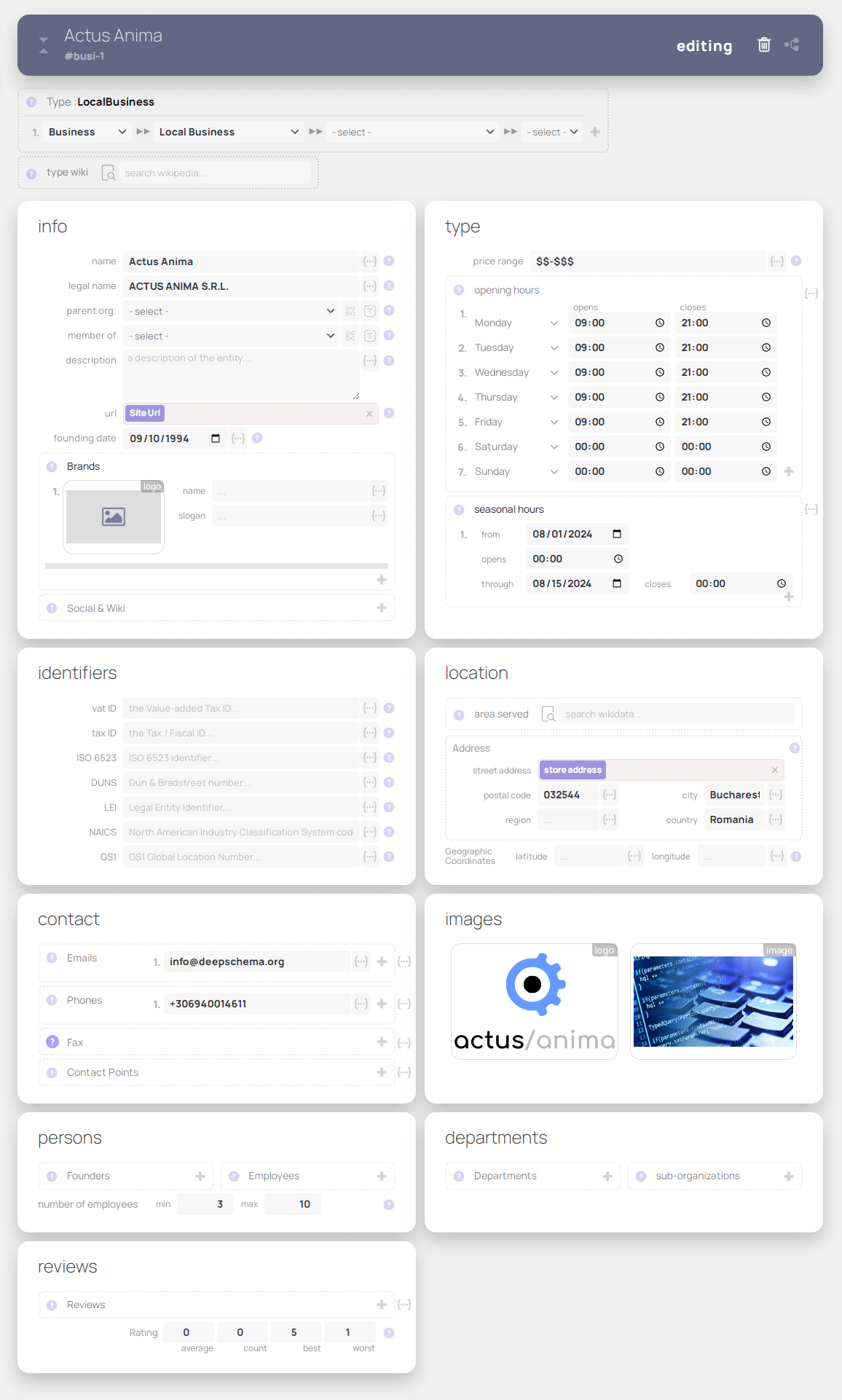Once you have installed and activated Actus Deep Schema, you can begin to refine the auto-generated schemas or create your own.
Website #

A good start is to take a look at the website schema. This schema contains the basic information about your website.
Most fields are already populated dynamically with data from WordPress. You can refine the name and description if you want, set an image for the website and provide information about the creator and publisher of the website.
We strongly suggest that you populate the Main Entities property on the content section. The best practice to do this, is to link other schemas to this property. For instance, assign a Business schema if your site pertains to a business, or a Person schema for individual-focused sites. You’ll find a pre-generated business schema available, ready to assign and refine, or create additional schemas for various entities like businesses, services, individuals, or other items.

Business / Organization #
The auto-generated Business schema has some of it’s values populated with data from WordPress.
It defaults to the LocalBusiness type, generally suitable for most businesses. However, you have the flexibility to choose a subtype within LocalBusiness that aligns better with your entity. Alternatively, you can switch to another type like OnlineBusiness or opt for the broader Organization type if it better represents your entity. Depending on your selection, different form fields may appear. To refine your entity further, utilize the “type wiki” field to provide Wikipedia terms that precisely define your entity type.
If you selected LocalBusiness or some one of it’s subtypes, then an address is required for the schema to be valid. You should access the location section and input some address details. After that, your Business schema will be valid, but it is recommended that you fill in as much info as you can in order to feed search engines with a rich schema. Clicking on the grey warning bar on the top of the form, you will see which fields are more important to populate first.
Audience #
If your website targets a specific audience (eg women 20-40) you can define that with an Audience schema. You can go the Audience section and either refine the pre-generated schema named “General Audience”, or create a new Audience schema. You can create as many audience schemas as you want and assign them to different webpages.
Web Pages #

Actus Deep Schema generates automatically a WebPage schema for every web page of your site so you don’t need to do much here. These schemas pull relevant data from your content and adjust schema types based on the page’s nature (like simple pages, archive pages, or post-specific pages).
Navigat to the WebPage Schemas for Special Pages section and set the About Page, the Contact Page and the Search Result Page of your website. There, you can assign the respective pages by typing their titles into the search box and selecting the appropriate page for each box.
To fine-tune the default settings for the auto-generated schemas, craft new defaults for specific targets, or edit the schema of specific pages, explore further details and options here: Web Pages.
Post Types #

In the Post Types section, you can assign specific schema types for every post type existing on your website. Here, you can also modify the defaults for the auto-generated schema created for each post.
Post is the default post type of WordPress. An Article schema is already assigned on this post type and Actus Deep Schema automatically generates an Article schema for every post, populating it with relevant data from your content.
If your website uses custom post types, you must assign a desired schema type to each post type in order to get auto-generated schemas for them. To do this, you select a schema type from the dropdown menu within the respective box. Then, you should click on the EDIT button and assign dynamic values on the schema properties. For more information about editing the defaults or creating new defaults for specific sets of posts, visit Post Types.
For post types that are generated by plugins that integrate with Actus Deep Schema, the proper schema types are assigned automatically (if you enabled integration). For example, if you are using Woocommerce, the Product schema is assigned on the product post type, and it’s defaults are populated with dynamic values that pull data from Woocommerce.
Final Notes #
In most cases, you get rich structured data for your website by just installing Actus Deep Schema and providing some info about your website and business. The schemas for webpages and items (post types) are highly automated but you can always go deeper and tweak the defaults or target specific sets of pages or posts. For comprehensive guidance on each section and schema type, detailed information is available in our comprehensive documentation Overview.




